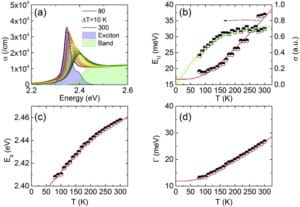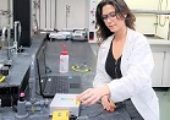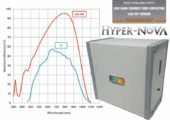C Wolf, TW Lee – Materials Today Energy, 2017
Abstract
Lead-halide based perovskite semiconductors have recently attracted significant attention owing to their rapidly increasing efficiency in solar cells and light-emitting devices. Organic–inorganic lead halideperovskites have gained popularity due to their low-temperature solution processability, low electronic defect density and low structural and thermal disorder. Nonetheless, their single crystals suffer from lower carrier mobility (∼10–100 cm2 V−1 s−1) than those in inorganic semiconductors and slow radiative recombination rates, with average lifetimes exceeding one μs. Recently, CsPbBr3, an all-inorganic lead-bromide perovskite also attracted great attention due to its high thermal stability and fast radiative recombination. Therefore, it is required to explore the exciton and lattice dynamics of solution processed CsPbBr3 thin films. Here, we show that CsPbBr3 exhibits an electron–phonon coupling strength (∼70 meV) comparable with its organic–inorganic hybrid perovskite counterpart CH3NH3PbBr3 (∼60 meV). The main source of electron–phonon coupling was identified to be the longitudinal-optical phonon mode of the Pb

1. Introduction
Lead-halide (PbBr2, PbCl2, PbI2)-based perovskite structures with the generic formula APbX3 (A = organic or inorganic cation, X = halide) have attracted a great attention due to rapid increase of electro-optical performance especially in solar cells and LEDs [1,2]. Early studies already indicated that the PbX6 octahedra dominates the optical properties with the band extrema being hybridized states of lead and halide orbitals [3].
An intriguing property is the low-temperature, solution processability of all commonly used APbX3perovskites which allows processing at temperatures generally considered compatible with flexible substrates and printing processes, thought to overcome limitations of generally expensive high-temperature, high vacuum processing currently employed in the semiconductor industry. The so far most studied variant of APbX3 contain an organic methylammonium (MA, CH3NH3) or formamidimium (FA, HC(NH2)) cation on the A-site and the halide is either iodine for solar cell applications [2,4] or chlorine and bromine for light-emitting diodes [5,6] owing to the strong band-gap dependence of the compound which gradually decreases along the halide group Cl > Br > I (3 eV > 2.3 eV > 1.6 eV) [7], almost irrespective of the A-cation. Combinations of the halide are known to span the whole visible spectrum, which has been explored for light-emitting applications as well [8]. Binding energy of the electron–hole pair or exciton is reported in the range of 2–60 meV and a decrease of the binding energy with temperature has been reported by some groups [9,10].
Currently two stringent limitations of organic–inorganic hybrid materials have emerged: The first is the limited carrier mobility in both, highly crystalline and polycrystalline samples [11]. The discrepancy between long carrier lifetimes and low carrier mobilities can be rationalized by strong coupling of the charge carriers to the lattice [12–14]. The second is the long carrier lifetime, driving high efficiency solar-cells but drastically limit efficient radiative recombination in light-emitting diodes (LED). A recent report has linked these long lifetimes to the motion of anisotropic MA and FA cations, but the effect is absent in isotropic cesium (Cs)-based perovskites [15]. Calculation has revealed that in CsPbI3 slow hole cooling due to coupling to the Pb
These findings motivate to replace the polar, anisotropic, organic A-site cation with the non-polar isotropic Cs. The resulting CsPbBr3 does not significantly differ from the organic–inorganic hybrid perovskites (MA or FAPbBr3) in terms of band-gap [18], but the distinctively different screening behavior of the excited carriers [15], strongly favors fast radiative recombination in CsPbBr3. The material is further known to be processable at low-temperatures around 300 K [19,20]. In addition, the completely inorganic compound has a higher temperature stability compared to the organic–inorganic hybrids and high-purity single crystals can be grown by conventional methods at high temperatures (700 °C) [21]. LED device fabrication is at an early stage but simple one-layer devices incorporating CsPbBr3 as emitter material already rival previously reported devices based on MAPbBr3 with record luminescence values of 176,000 cd m−2 and peak external quantum efficiencies of ∼6% [6,22,23].
Here, we aim to detail the physics underlying photon absorption and emission and the interaction of carrier and lattice in solution processed CsPbBr3 by temperature-dependent UV/VIS absorption and photoluminescence (PL) spectroscopy and density-functional (DFT) calculation. Temperature-dependent PL data allowed the identification of two PL quenching channels, one being assigned to the facile thermal ionization of excitons due to their small exciton binding energy (40 meV) in good agreement with DFT calculation and literature and the other suspected to be a halide vacancy defect state. We analyzed the electron–phonon coupling from temperature dependent PL broadening, which stems from a longitudinal-optical (LO) phonon mode of 20 meV, found in the Raman spectrum and by density functional perturbation calculation. From absorption data we are able to determine the band-gap shift, which is shown to follow a blue-shift with increasing temperature. The Urbach disorder energy extracted from the exponential onset of absorption reveals low structural disorder and dominantly thermal disorder which, again, can be attributed to the same LO phonon mode. The total disorder at room-temperature is less than 40 meV. The Fröhlich coupling constant for an LO-coupled polaron is α∼1.1, comparable to many polar inorganic semiconductors. The electron–phonon coupling constant obtained from PL broadening of CsPbBr3 is ∼70 meV, comparable to that of their organic–inorganic hybrid counterpart CH3NH3PbBr3 (60 meV). Analysis of the photoluminescence lifetime using stretched exponentials revealed short lifetimes and a high order parameter β≈0.7 at low temperatures, indicative of efficient, excitonic recombination. The order parameter shows a distinct temperature dependence which can be linked to the influence of thermal disorder on the recombination of carriers. Overall CsPbBr3 shows comparable electron–phonon coupling, and more efficient carrier-recombination than MAPbBr3 whilst maintaining solution-processability with low electronic disorder.
… For steady-state PL experiments a pulsed laser diode (LDH 405 nm controlled with a PDL 800-D, both PicoQuant GmbH, average power <1.6 mW at 40 MHz, spot diameter on sample less than 1 mm) was used for excitation and the PL spectra were collected using a fiber-coupled StellarNet blue wave spectrometer. Using lower excitation density is prohibited by the sensitivity of the detector. For power-dependent PL spectroscopy the continuous-wave (CW) mode of the same laser-diode is used. The laser-power is then varied between 0.4 mW and 54 mW (determined using a laser power-meter, Thorlabs S302C with a nominal power range of 10−4 to 2 W). The collected spectra were analyzed using Matlab by fitting a single Gaussian to each spectrum. The reported values for σ correspond to the Gaussian width and are related to the FWHM by FWHM ≈ 2.355 × σ. Constrained fits using Matlab’s fmincon routine were used and show excellent convergence with R2 exceeding 0.99 over the whole temperature range indicating the general Gaussian emission shape.





